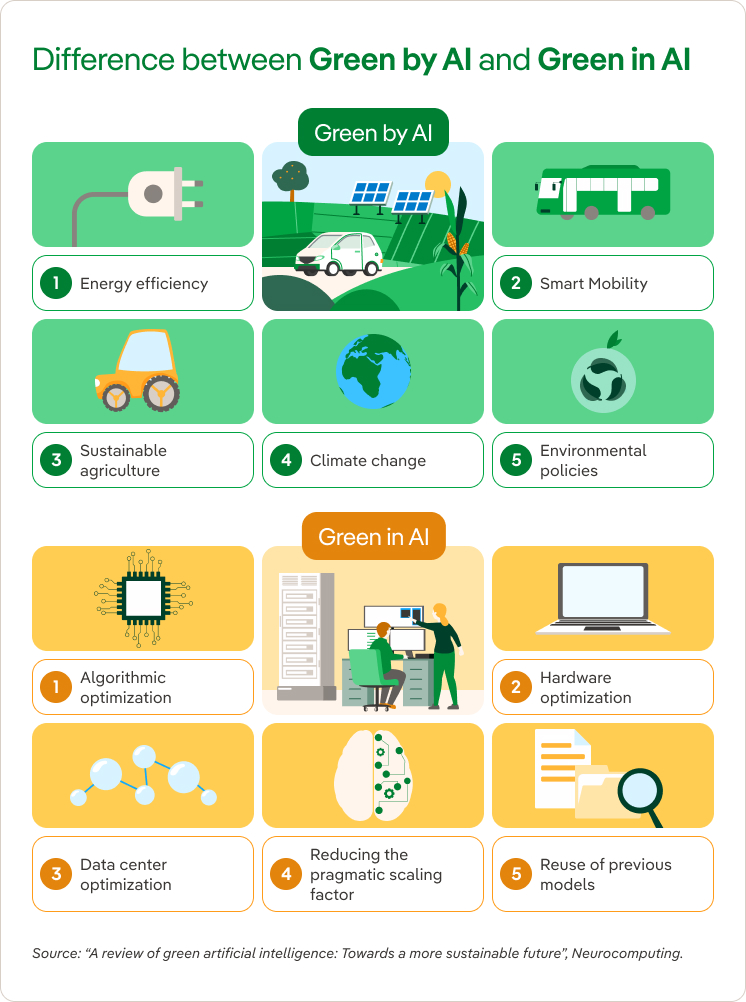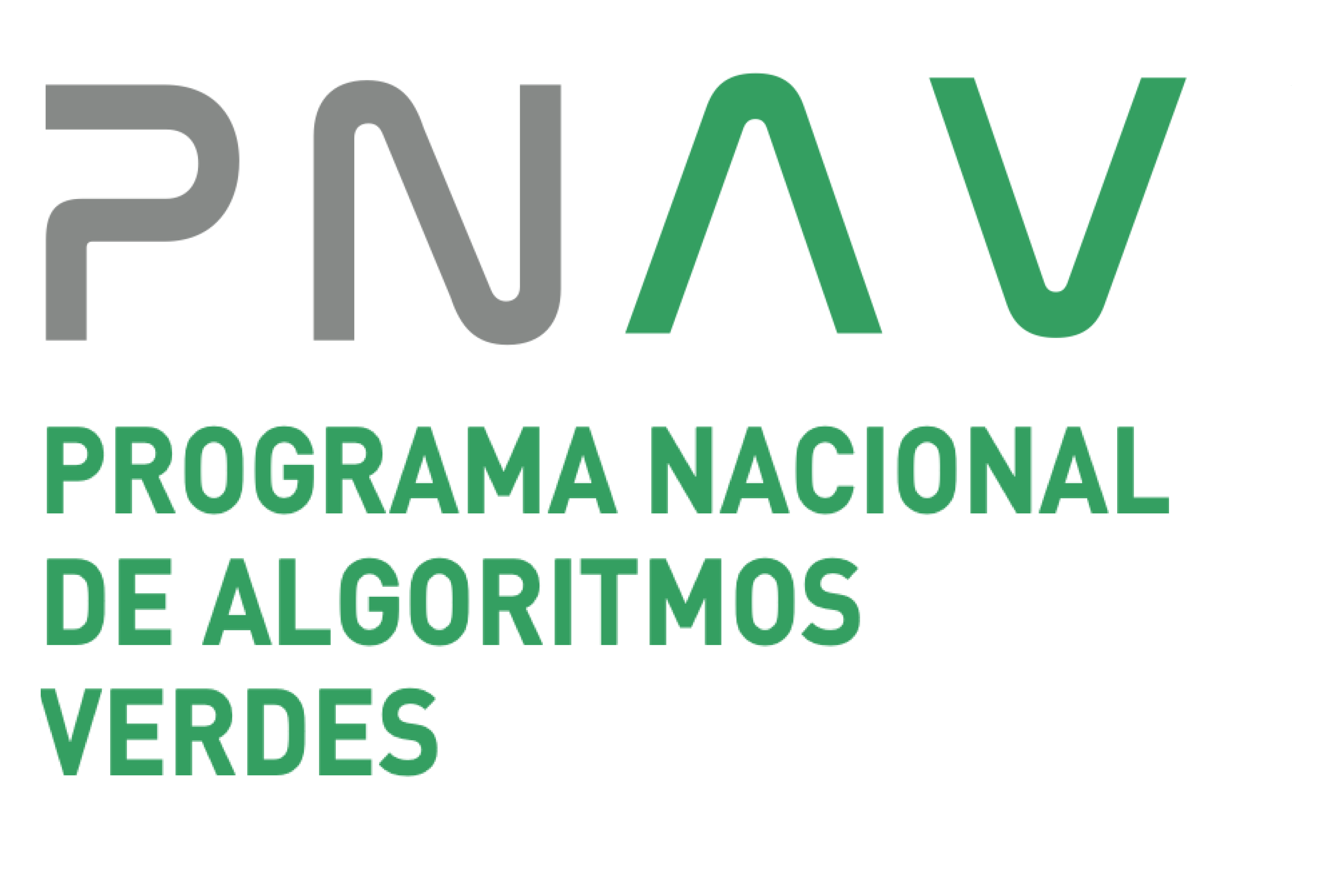Green artificial intelligence
The convergence of artificial intelligence and sustainability: green artificial intelligence
The emergence of artificial intelligence (AI) technologies has transformed the way we work, interact, make decisions and solve complex problems across many sectors. However, as these tools become more central, so too does concern about their environmental impact, driven by the high energy demand associated with training and operating AI models. Green artificial intelligence has emerged as one of the main mitigation pathways that take into account the carbon footprint generated by conventional AI. Its goal is not only to minimise its own impact but also to maximise the usefulness of AI algorithms in the fight for sustainability.

November 2025

Approximately 11 minutes

We may not see AI, but it is usually present. Weather forecasting, GPS navigation and online recommendations, along with many other daily digital tasks, rely on large artificial intelligence systems. Although these technologies offer major advantages, they also have a measurable impact on the environment as they significantly increase the consumption of energy and other resources.
As the production and integration of AI models advance, so does concern about developing technology that is compatible with the planet amid the ongoing energy transition. This is the foundation of green artificial intelligence, a concept that is becoming increasingly relevant across the sector.
What is green artificial intelligence?
AI and the energy sector share a symbiotic relationship that operates in both directions. Green AI refers either to applications that aim to improve efficiency, reduce electricity consumption and enhance ecosystems (Green by) or to making AI itself intrinsically more energy-efficient at both the hardware and software level, regardless of its use (Green in).

 SEE INFOGRAPHIC: Difference between Green by AI and Green in AI [PDF]
SEE INFOGRAPHIC: Difference between Green by AI and Green in AI [PDF]
Green artificial intelligence, in its “Green in AI” dimension, is an emerging approach that aims to reduce the environmental impact of AI technologies through more sustainable practices. This view includes optimising algorithms and models to consume less energy, using more efficient infrastructure and implementing hardware designed to minimise electricity use.
This paradigm holds that achieving lower energy consumption requires balance between the volume of data needed to train models, the training time and the number of interactions required to optimise them. The result is a set of highly efficient technologies that can boost the deployment of AI applications.
-
Renewable origin: self-consumption and storage to maximise efficiency.
Dataset optimisation: removing low-value data.
Algorithm optimisation: reducing parameters or using techniques such as Mixtures of Experts to optimise consumption.
Appropriate hardware: not only avoiding obsolescence but also using specialist equipment such as tensor processing units (TPUs) or vision processing units (VPUs).
Efficient inference: applications that store key queries to avoid repeated inferences.
Efficient modules: optimising rack placement, cooling type and computing density to ensure energy is used effectively.
Efficient buildings: the final step in lowering AI’s footprint is reducing consumption for heating and cooling, lighting, security and other operational needs in buildings and campuses.
At the same time, it emphasises the importance of prioritising renewable energy sources in data centres and in the infrastructure and technology used to train and run AI models, helping reduce their carbon footprint. It also calls for transparency in measuring and reporting energy use and CO₂ emissions in these processes.
Green artificial intelligence in its “green by AI” dimension encompasses initiatives that apply AI technologies to environmental challenges, such as optimising logistics or resource management processes that have environmental impact or improving energy consumption through advanced weather forecasting or consumption and market management models.
This convergence of artificial intelligence and sustainability advocates for more responsible strategies that ensure technological progress aligns with global sustainability objectives. It is another step towards an ecological future that does not sacrifice progress.
Why is green AI important? The environmental footprint of artificial intelligence
Artificial intelligence tools have a life cycle made up of different phases, each of which can have a harmful impact on the environment. These are some key figures:
-
In 2024, data centres consumed around 415 TWh.
-
By 2030, data centres are expected to consume 945 TWh, equivalent to Russia’s total electricity consumption.
-
GPT-3.5 (ChatGPT) is estimated to have consumed about 1.3 GWh for training, while GPT-4 required 50 GWh.
-
If every Google search used generative AI, daily consumption would reach 80 GWh, exceeding Ireland’s total daily electricity consumption, compared with 1 GWh today for indexed searches.
-
ChatGPT consumes about 620 MWh per day from its users, meaning that every two days it consumes the same amount of energy it needed for training.
-
Training and inference to date for GPT-3 and GPT-4 (used in ChatGPT) are estimated to have consumed 380 GWh.
Sources: “We did the math on AI’s energy footprint. Here’s the story you haven’t heard”, External link, opens in new window. MIT Technology Review; “AI Environment Statistics 2025: How AI Consumes 2% of Global Power and 17B Gallons of Water”,
External link, opens in new window. MIT Technology Review; “AI Environment Statistics 2025: How AI Consumes 2% of Global Power and 17B Gallons of Water”, External link, opens in new window. All about AI.
External link, opens in new window. All about AI.
Data centre electricity consumption by region, Base Case, 2020-2030
The International Energy Agency (IEA) predicts that the United States, China and Europe will continue to be the regions with the highest electricity demand for data centres in the coming years. China and the United States are the most important regions in terms of growth in data centre electricity consumption, accounting for almost 80% of global growth until 2030.
- 1000
- 800
- 600
- 400
- 200
- 0
- 2020
- 2021
- 2022
- 2023
- 2024
- 2025
- 2026
- 2027
- 2028
- 2029
- 2030





- United States
- China
- Europe
- Asia excluding China
- Rest of world
Source: International Energy Agency (IEA)
 SEE INFOGRAPHIC: Data centre electricity consumption by region [PDF]
SEE INFOGRAPHIC: Data centre electricity consumption by region [PDF]
Factors contributing to carbon emissions in AI
-
Training large-scale models
-
Infrastructure and data centres
-
Hardware production and disposal
Mitigation strategies
-
Model and algorithm optimisation: Understanding models, green algorithms and efficient training with methods such as transfer learning: initial training on a general task followed by fine-tuning for specific ones rather than training from scratch.
-
Use of renewable energy: Migrating data centres to renewable energy sources and implementing energy storage technologies.
-
Hardware optimisation: Improving hardware manufacturing and recycling, encouraging energy efficiency and reuse.
-
Regulation and standards: Developing standards that promote energy efficiency and sustainability and implementing tax incentives and rules that encourage the use of renewable energy.
-
Monitoring and reporting emissions: Encouraging transparency in energy consumption and carbon emissions reporting by AI companies, together with tools to help reduce them.
Green algorithms
Algorithms underpin the interactions we carry out with and through the digital devices we use every day. They enhance our experience when completing routine tasks, such as searching for content online or using a chatbot designed to respond immediately to requests. AI algorithms are no exception to the carbon footprint produced and can even amplify it: when sustainability considerations are absent from their design, they can have a significant environmental cost.
Green algorithms, created as an ecological alternative, include strategies and computational programming methods aimed at minimising the environmental impact associated with their execution. The aim is to reduce the consumption of resources and energy and therefore the carbon footprint associated with digital systems.
For green AI algorithms to be effective, two distinct phases of their life cycle must be considered:
Several countries and international organisations are working to develop national green algorithm plans and initiatives to measure the environmental impact of this technology and ensure its quality and sustainability.
The European Union identifies AI as a strategic area of development and is promoting projects that apply AI in a sustainable manner. These continuously evolving initiatives aim to encourage the energy efficiency of AI and establish policies for sustainable AI. European coordination is shaped around the AI Act of August 2024 and its implementation is planned through the AI Pact, Enlace externo, se abre en ventana nueva. which Iberdrola became the first European energy company to join in September 2024.
Enlace externo, se abre en ventana nueva. which Iberdrola became the first European energy company to join in September 2024.
In Spain, AI oversight is organised through the Spanish Agency for the Supervision of Artificial Intelligence (AESIA). Key programmes in this area include:

Spain’s National Green Algorithms Programme (PNAV)
An Spanish initiative in which Iberdrola collaborates to promote research into sustainable AI. Its aim is to encourage the use of renewable sources and ensure efficient energy consumption.

Green Tech Quality Seal
A forthcoming certification that will recognise AI models that meet sustainability criteria and will apply to companies developing sustainable hardware and software.

Spain’s National Green Algorithms Programme (PNAV)
An Spanish initiative in which Iberdrola collaborates to promote research into sustainable AI. Its aim is to encourage the use of renewable sources and ensure efficient energy consumption.

Green Tech Quality Seal
A forthcoming certification that will recognise AI models that meet sustainability criteria and will apply to companies developing sustainable hardware and software.
Among the standout reference resources is the Energy and AI World Energy Outlook [PDF] report by the International Energy Agency (IEA), presented following the 2024 World Conference on Energy and Artificial Intelligence. External link, opens in new window. The document seeks to bridge the knowledge gap using new global and regional models and datasets, together with broad consultation with governments, regulators, the technology sector, the energy industry and international experts. It includes projections of how much electricity AI could consume over the next decade and which energy sources are expected to support this demand. It also analyses what AI adoption may mean for energy security, emissions, innovation and affordability.
External link, opens in new window. The document seeks to bridge the knowledge gap using new global and regional models and datasets, together with broad consultation with governments, regulators, the technology sector, the energy industry and international experts. It includes projections of how much electricity AI could consume over the next decade and which energy sources are expected to support this demand. It also analyses what AI adoption may mean for energy security, emissions, innovation and affordability.
Measurement tools
Spain’s Secretariat of State for Digitalisation and Artificial Intelligence (SEDIA), together with the Spanish Association for Standardisation (UNE), recently published a pioneering technical specification to measure the environmental impact of AI systems. This initiative forms part of the National Green Algorithms Programme (PNAV) and of the 2024 National Artificial Intelligence Strategy.
The new regulatory framework establishes common criteria for assessing energy consumption, carbon footprint, water use and the performance of AI models, especially during training and implementation. The specification provides detailed guidance for quantifying environmental impact, with particular emphasis on generative AI systems and large language models (LLMs) due to their high computational load.
More than 40 experts took part in its development, including researchers in green algorithms, technology companies, AI specialists and certification bodies offering verification perspectives. Iberdrola’s Technology area was among the contributors.
Alongside these standardisation activities, various AI-consumption measurement tools have been created and are continually updated to adapt to new models and AI architectures. Examples include:
- PyJoules, a Python tool that measures energy consumption during code execution using hardware sensors such as Intel RAPL and NVIDIA NVML to assess system and algorithm efficiency.
- CodeCarbon, a lightweight open-source Python tool that estimates CO₂ emissions generated by computing resources used to execute code, helping optimise processes and reduce environmental impact.

History of artificial intelligence
Discover its history and how we at Iberdrola are taking advantage of this technology.

Evolution of Artificial Intelligence
Find out how AI has evolved over the years.

Types of AI Algorithms
Learn about the types of algorithms used by Artificial Intelligence.
Challenges for the development of sustainable artificial intelligence
The development of green AI faces several challenges that must be addressed to minimise environmental impact and ensure responsible use of technology. These include:
















